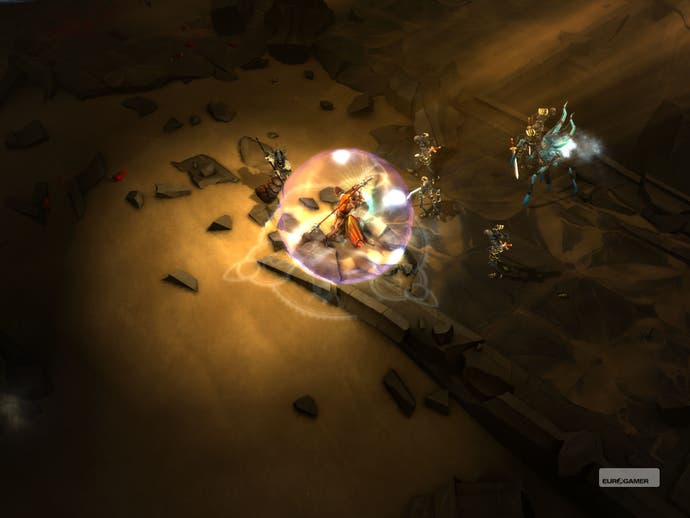Diablo III
A tale of four classes.
Blizzard says it's focusing on character class reveals for Diablo III - like the recent unveiling of the Monk at BlizzCon - because "seeing a guy running around exploding people" offers the most bang per buck, and conveniently avoids story spoilers to boot. That's logical - but it's hard not to think that there's something more to it.
For all that we're promised a more fully realised world and a richer questing and storytelling experience in this sequel, there's definitely an extent to which, in Diablo games, the classes are the content. Sky-high level caps and ocean-deep customisation make each one an epic journey in itself. The randomised dungeons are a canvas for their self-expressive slaughter; the monster designs a counterpoint to their spectacular skills; the multiplayer a lab to experiment with their interactions; the difficulty levels and ladder play a stress-test for their design. Diablo games are simple, immediate action-RPGs on the surface, but the classes turn them into bottomless wells to plumb, and they have tempted countless Diablo II players into countless replays.
Diablo III certainly won't be any different in that respect - but the classes themselves, and therefore everything you can assume about the game itself, certainly will be. Of the four classes revealed so far, only the Barbarian returns from the previous game, and even that monster-smashing brute is transformed by more sophisticated skills and a resource system that's all about momentum. The Wizard, Witch Doctor and Monk move progressively further and further away from Diablo tradition and standard RPG archetypes into a world where you find designers name-checking Street Fighter and God of War.

There are still many things we don't know about Diablo III: how the rune skill customisation system will work (it wasn't in the build of the game at BlizzCon, as the designers are still iterating on this terrifyingly flexible feature); how randomised events will spice up the more carefully-crafted "overworld"; what form player-versus-player combat will take; and what the Battle.net online feature set will be (although, after the example set by StarCraft II, expectations are very high indeed). But the game is defined by its classes, and all four were available to play over a very extensive demo at BlizzCon. So I hogged a terminal for as long as I dared to delve into each one, and discussed them in detail with lead world designer Leonard Boyarsky and lead designer Jay Wilson. This is what I found.
The Monk
Boyarsky: "They're really religious holy men, they are raised from childhood in secluded monasteries where they are taught to be pure expressions of their deities through perfection of their fighting techniques. They have 1001 gods and they go so far as to tattoo a symbolic representation of them all over their backs, it's this intricate design and it takes their whole life to complete... When they're not fighting they're training to fight, they spend their time in deep meditation to cleanse sin from themselves... They're equally feared and respected, even by their own citizens, because they are a little bit - you know, they dedicate their whole lives to this. The guy who dedicates his whole life to fighting in the service of God is not a guy you want to see coming down the street for you."
Wilson: "One of the things that we're really excited about with that class is the contradiction of a melee class who is fragile, who has this really high-risk placement. A character who can also have a little bit more diversity than the Barbarian in that we can use magic, we can use a broader range of defensive skills and really focus on speed... We're also really focusing on the idea of making a fighting game character. Something that would probably hold more to, say, God of War or Street Fighter than Warcraft or Diablo II."

A combo-driven brawler you control with a mouse? A close-range fighter with hardly any more armour than a ranged spellcaster? A holy warrior who is looks like a Latvian crusader and moves like a Shaolin disciple? The Monk sounds like a mess of contradictions, but the only mess he makes is by punching enemies so hard their hearts explode.
The fighting-game influence is partly, but not purely, stylistic. The Monk's lightning-speed rampages are defined by exaggerated Shaw Brothers sound effects, sudden frame-jumps, dash-lines and even 2D cutouts when you trigger Seven-sided Strike, a skill that teleports him around a group of enemies in quick succession to hit each one. But it's also about how crisp and precise he is to control, how immediately his blows land - a logical but still extreme extension of the button-mashing Diablo play-style, where reflexes matter more than juggling cooldowns.








